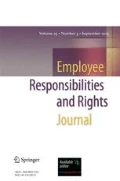One characteristic of the US economy is the proliferation of the merger of companies. Often referred to as merger and acquisitions, the first wave occurred from 1897 to 1904 in industries such as railroads and electricity which were largely monopolies. The fifth wave took place in 1999 to 2000 and was primarily driven by globalization, deregulation and the dramatic rise in the stock market. As industrial capital became larger throughout the twentieth century, labor unions adopted a similar strategy to defend their members. A union merger occurs when two or more labor organizations join into one body for the purpose of taking advantage of the efficiencies of scale in recruiting members as well as negotiating and administering labor contracts. While it is hoped that union mergers will be successful in promoting the members’ interests, this is, unfortunately, not always the case as with the 2004 UNITE-HERE merger.
In this well-written and interesting “Perspectives” Section essay, Dr. Gary Chaison, Professor Emeritus of Industrial Relations at the Graduate School of Management at Clark University where he was a faculty member for 35 years, and perhaps the foremost authority in the United States on union mergers, has written an analysis of the 2004 merger between UNITE and HERE. While there was great hope that this merger would revitalize the US trade union movement and lead to increased success in union organizing, the merger was a failure. Chaison contends that this merger was problematic from its inception because the two unions lacked a common jurisdiction, were of different sizes and contained dissimilar types of union members. He also examines a number of issues relevant to union mergers before tackling the question of whether union mergers can contribute to a reinvigoration of the US trade union movement at the end of the twenty-first century’s second decade.
If any of the journal’s readers are interested in responding to any essays published in the “Perspectives” Section or would like to write articles on any topics in the field of employee relations, please do not hesitate to contact me with your proposal. I welcome both practitioner-based and scholarly-based articles written from any one of a variety of theoretical perspectives. I hope that you enjoy this article and find it most illuminating.
Author information
Authors and Affiliations
Corresponding author
Rights and permissions
About this article
Cite this article
Devinatz, V.G. Introduction to “Union Mergers; Some Questions Raised by a “Disorderly Breakup””. Employ Respons Rights J 30, 297 (2018). https://doi.org/10.1007/s10672-018-9322-z
Published:
Issue Date:
DOI: https://doi.org/10.1007/s10672-018-9322-z

